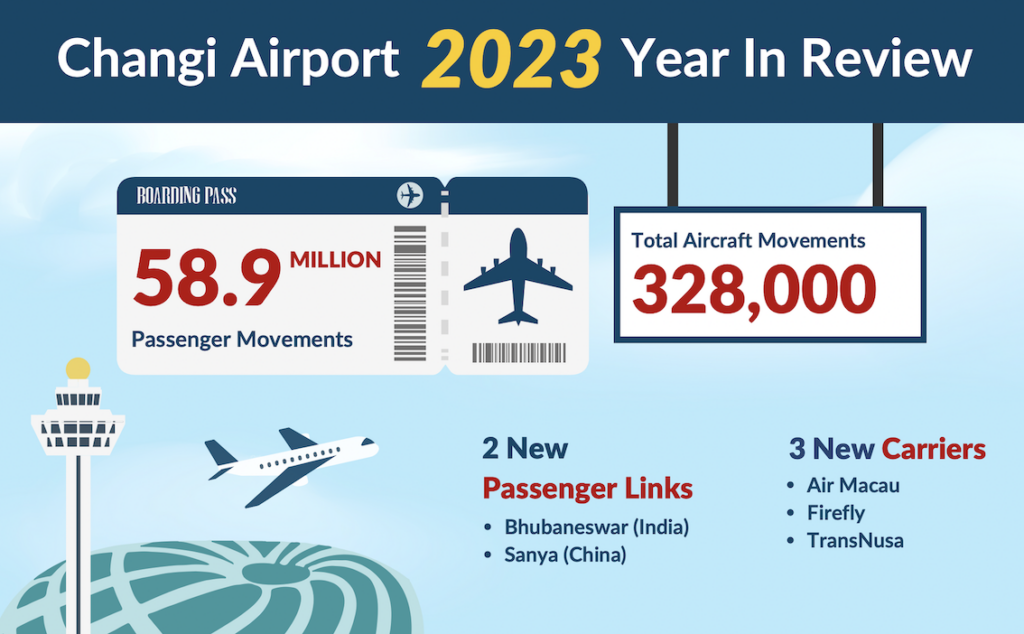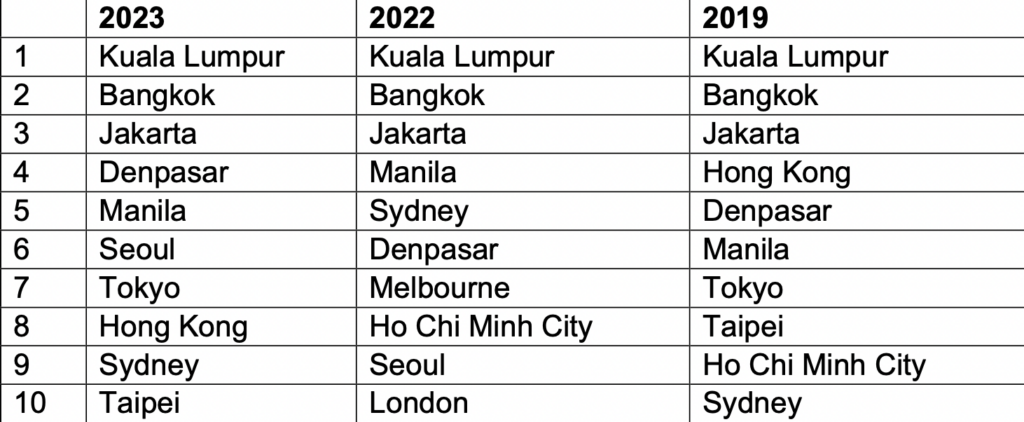SINGAPORE. Singapore Changi Airport served 58.9 million passengers in 2023, almost double the figure posted in 2022 and representing 86% of the traffic level in 2019.
For the quarter from October to December, passenger traffic passed 90% recovery compared to pre-pandemic 2019 with 16.1 million passengers.
December was the busiest month of the year at 5.8 million passengers or 91% of traffic in December 2019. The busiest day of the year was 22 December when 203,000 passengers passed through Changi’s terminals.

Compared to pre-Covid passenger traffic, the North America region posted the strongest growth in 2023, exceeding 2019 levels by more than +25%, while Europe, Southwest Pacific and South Asia are close to full recovery, registering over 90% of 2019 traffic levels.
All regions continued to register strong recovery year-on-year. Northeast Asia was the front runner, with passenger traffic increasing more than four times that of 2022, largely due to a leap in travel between China and Singapore. Southeast Asia posted the second strongest growth (+72%) during the year.
Changi Airport’s top five passenger markets for the year were Indonesia, Malaysia, Australia, Thailand and India. Among Changi’s top ten markets, China, Japan and South Korea were the fastest growing compared to 2022.

With the easing of travel restrictions, China regained its spot in Changi’s top ten markets, closing the year at number six with close to four million passengers. Passenger traffic between Japan and Singapore tripled compared to 2022, while South Korea traffic exceeded pre-pandemic levels by +36%, making it the market with the strongest rebound compared to pre-Covid traffic.
Kuala Lumpur, Bangkok, Jakarta, Denpasar (Bali) and Manila were Changi Airport’s busiest routes during the year – Kuala Lumpur route was the world’s busiest international route based on seat capacity (OAG).

Changi Airport Group Executive Vice President for Air Hub and Cargo Development Lim Ching Kiat said, “2023 was an invigorating year, as we witnessed the resounding resumption of travel across the world, as well as the full reopening of Changi Airport’s Terminal 2. The upswing in travel was fuelled by strong outbound travel demand, as well as growing inbound travel.
“The growth in passenger traffic was especially strong in Asia, with an acceleration seen in the last quarter. Changi Airport also resumed connections to more than ten cities this year, including Addis Ababa, Changsha, Ningbo, Kaohsiung and Okinawa. We have restored almost 90% of our pre-Covid city links to date, with Changi Airport now the fifth busiest airport in the world by seat capacity.
“We step into 2024 hopeful of making a full recovery back to Changi Airport’s pre-Covid connectivity and traffic levels. As more travellers around the world rekindle their wanderlust, we will continue to work with our airline partners to bring exciting destinations and new travel experiences to travellers.”
Enhancing connectivity
In 2023, Changi Airport welcomed three new passenger airlines – Air Macau, Firefly and TransNusa – and added two new passenger city links to its network – Bhubaneswar (India) and Sanya (China).

Changi Airport also established its first link to Beijing Daxing Airport via China Eastern Airlines. Through a three-year partnership between Singapore Tourism Board, TUI Airways and Marella Cruises, Changi Airport will welcome fly-cruise passengers from the UK to Singapore between December to April each season, for three years till 2026. TUI Airways operates three times weekly services from London Gatwick, Manchester and Birmingham.
Air Canada announced its return to Changi Airport after more than 30 years, and will commence its four-times weekly non-stop Vancouver-Singapore service in April. Singapore Airlines will also launch new passenger services to Brussels and London Gatwick, from April and June respectively.
As of January 2024, 93 airlines operate over 6,700 weekly scheduled flights at Changi Airport, connecting Singapore to 154 cities in 49 countries and territories. ✈














